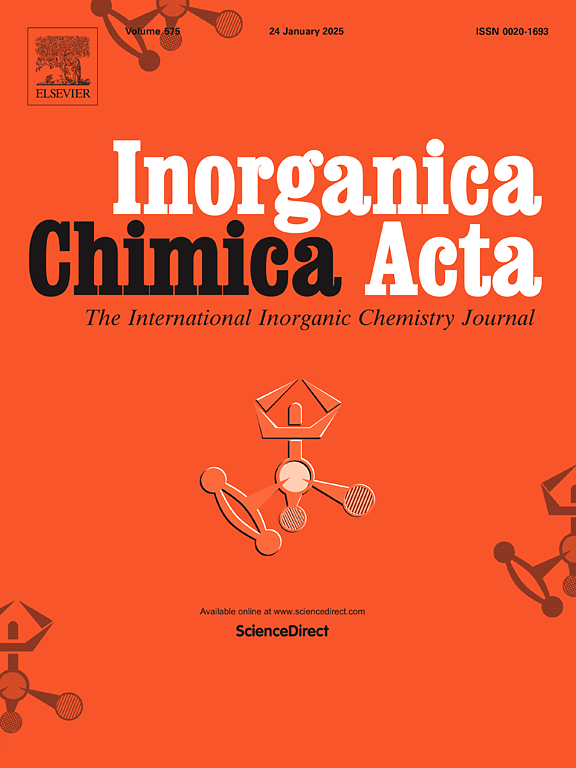从钴(II)、镍(II)和铜(II)(2-硫)巴比妥酸盐到它们的咪唑基络合盐:合成、结构、物理化学和生物学性质
IF 2.7
3区 化学
Q2 CHEMISTRY, INORGANIC & NUCLEAR
引用次数: 0
摘要
合成了一系列以1,3-二嗪烷-2,4,6-三酮(H2BA, C4H4N2O3)或2-磺酰基-1,3-二嗪烷-4,6-二酮(H2TBA, C4H4N2O2S)为基础的金属(II)配合物,分子式为[M(H2O)4(HBA)2] (1,2), [Cu(H2O)3(HBA)2](3)和[M(H2O)2(HTBA)2] (4,5) (M = Co, Ni)。然后用这些化合物得到新型络合盐[M(H2O) M(Im)n](H(T)BA)2·pH2O (M = 0或2,n = 4或6,p = 0、2或4)和[Cu(H2O)(Im)4](HBA)2·3H2O,其中Im为1h -咪唑(C3H4N2)。采用元素分析、FT-IR、XRD和TG-DSC对分离产物进行了表征。配合物1-5微溶于水(-logKsp范围从5的5.10到4的7.45),并在220-300°C开始氧化降解。发现了[MH(T)BA]+物质在酸性溶液中的存在,并利用溶解度法和ph法测定了它们的β11值,其变化范围在~ 2-3个对数单位之间。除了一些例外,金属(II)咪唑配合物比1-5更容易溶解,但Im和H(T)BA的分解分别在130-175°C和325-450°C开始。紫外-可见光谱法证实了它们在水中溶解后内配位球的保存。光谱具有典型的金属(II) -Im体系的λmax值:~ 500 nm (Co2+), ~ 632 nm (Ni2+)和~ 631 nm (Cu2+)。在盐的晶体结构中,水分子、配合的阳离子和相应的阴离子通过氢键组装成三维超分子框架。在生物学试验中,只有镍(II)咪唑配合物对大肠杆菌的抑菌活性增强。铜基化合物对SKOV3癌细胞的细胞毒性明显高于对HepG2细胞的毒性。本文章由计算机程序翻译,如有差异,请以英文原文为准。

From cobalt(II), nickel(II) and copper(II) (2-thio)barbiturates to their imidazole-based complex salts: Synthesis, structure, physicochemical and biological properties
A series of metal(II) complexes based on 1,3-diazinane-2,4,6-trione (H2BA, C4H4N2O3) or 2-sulfanylidene-1,3-diazinane-4,6-dione (H2TBA, C4H4N2O2S) with the formula [M(H2O)4(HBA)2] (1, 2), [Cu(H2O)3(HBA)2] (3) and [M(H2O)2(HTBA)2] (4, 5) (M = Co, Ni) were synthesized. These compounds were then used to obtain novel complex salts [M(H2O)m(Im)n](H(T)BA)2 · pH2O (m = 0 or 2, n = 4 or 6, p = 0, 2 or 4) and [Cu(H2O)(Im)4](HBA)2 · 3H2O, where Im is 1H-imidazole (C3H4N2). The isolated products were characterized using elemental analysis, FT-IR spectroscopy, XRD and TG–DSC. Complexes 1–5 were slightly soluble in water (–logKsp ranged from 5.10 for 5 to 7.45 for 4) and started to undergo oxidative degradation at 220–300 °C. The presence of [MH(T)BA]+ species in acidic solutions was revealed, and their β11 values, which varied within a range of ∼2–3 log units, were determined using the solubility method and pH-metry. Metal(II) imidazole complexes, with some exceptions, were more soluble than 1–5, but their decomposition started to occur at 130–175 and 325–450 °C for the Im and H(T)BAˉ moieties, respectively. The preservation of their inner coordination sphere after dissolution in water was confirmed by UV–Vis spectroscopy. The spectra had typical λmax values for metal(II)–Im systems: ∼500 nm (Co2+), ∼632 nm (Ni2+) and ∼631 nm (Cu2+). In the crystal structures of salts, 3D supramolecular frameworks were assembled by water molecules, complex cations and corresponding anions through hydrogen bonding. During biological testing, only nickel(II) imidazole complexes demonstrated enhanced bacteriostatic activity against E. coli. The cytotoxicity of copper-based compounds was significantly higher for SKOV3 cancer cells than against HepG2 cells.
求助全文
通过发布文献求助,成功后即可免费获取论文全文。
去求助
来源期刊

Inorganica Chimica Acta
化学-无机化学与核化学
CiteScore
6.00
自引率
3.60%
发文量
440
审稿时长
35 days
期刊介绍:
Inorganica Chimica Acta is an established international forum for all aspects of advanced Inorganic Chemistry. Original papers of high scientific level and interest are published in the form of Articles and Reviews.
Topics covered include:
• chemistry of the main group elements and the d- and f-block metals, including the synthesis, characterization and reactivity of coordination, organometallic, biomimetic, supramolecular coordination compounds, including associated computational studies;
• synthesis, physico-chemical properties, applications of molecule-based nano-scaled clusters and nanomaterials designed using the principles of coordination chemistry, as well as coordination polymers (CPs), metal-organic frameworks (MOFs), metal-organic polyhedra (MPOs);
• reaction mechanisms and physico-chemical investigations computational studies of metalloenzymes and their models;
• applications of inorganic compounds, metallodrugs and molecule-based materials.
Papers composed primarily of structural reports will typically not be considered for publication.
 求助内容:
求助内容: 应助结果提醒方式:
应助结果提醒方式:


